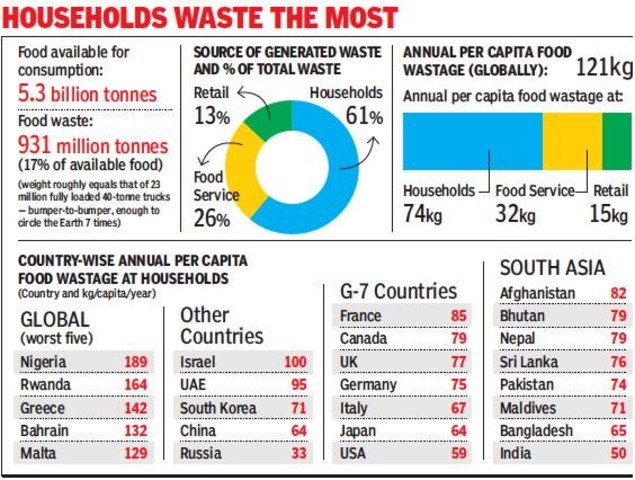Food waste: India
(Created page with "{| class="wikitable" |- |colspan="0"|<div style="font-size:100%"> This is a collection of articles archived for the excellence of their content.<br/> Additional information ma...") |
Revision as of 21:32, 7 March 2021
This is a collection of articles archived for the excellence of their content. |
Food waste index and India
2019
Vishwa Mohan, March 5, 2021: The Times of India

From: Vishwa Mohan, March 5, 2021: The Times of India
50kg of food wasted per person per year in Indian homes: UNEP
NEW DELHI: An estimated 931 million tonnes of food, or 17% of total food available to consumers in 2019 globally, went into the waste bins of households, retailers, restaurants and other food services, said the Food Waste Index Report 2021, released by the United Nations Environment Programme (UNEP) on Thursday.
The weight of the global food waste roughly equals India’s total production of foodgrain, oilseeds, sugarcane and horticultural produce, put together, in 2019-20. The report shows that most of this waste globally comes from households followed by food services and retail outlets.
On a global per capita level, 121 kg of consumer-level food is wasted each year, with 74 kg of this happening in households.
In South Asia, estimates at the household level show a waste of 50 kg of food per person per year in India compared to 82 kg in Afghanistan, 79 kg in Nepal, 76 kg in Sri Lanka, 74 kg in Pakistan and 65 kg in Bangladesh.
Per capita, food wastage is, in fact, much higher in west Asian and sub-Saharan African countries compared to South Asian and most of the European and North American countries, challenging earlier narratives of higher consumer food waste in developed countries, and food production, storage and transportation losses in developing countries.
Referring to the Food and Agriculture Organization of the UN (FAO) which estimates that 690 million people were hungry in 2019, the food waste index report said the number was expected to rise sharply during and post-Covid-19.
“With a staggering 3 billion people that cannot afford a healthy diet (FAO, 2020), the message of this report is clear: citizens need help to reduce food waste at home,” said the report comprising of new global consumer-level food waste estimates that were generated from existing data points in 54 countries and extrapolations based upon the estimates observed in other nations.
Underlining that the food waste is not just limited to rich nations, the report noted that the household per capita food waste generation is found to be broadly similar across country income groups, suggesting that action on food waste is equally relevant in high, upper-middle and lower-middle-income countries.
The report, joint research work of UNEP and UK-based non-governmental organisation WRAP, also flags that 8-10% of global greenhouse gas emissions (GHG) are associated with food that is not consumed.
“Reducing food waste would cut GHG emissions, slow the destruction of nature through land conversion and pollution, enhance the availability of food and thus reduce hunger and save money at a time of global recession,” said Inger Andersen, executive director of UNEP.
The UN body claimed that the research was conducted to support global efforts to halve food waste by 2030 under the 2015 sustainable development goals (SDGs).
“With only nine years to go, we will not achieve SDG (target 12.3) if we do not significantly increase investment in tackling food waste in the home globally. This must be a priority for governments, international organisations, businesses and philanthropic foundations,” said Marcus Gover, CEO of the WRAP.